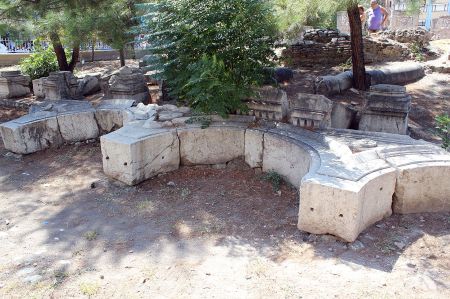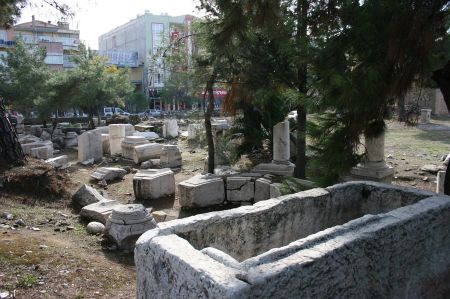Akhisar was once the trading capital of Thyateira
- Written by Portal Editor
A few days' stay in Izmir also allows us to take a day trip to Akhisar, the county seat of the district of the same name in Manisa Province, about 90 kilometers from Izmir.
Coming from Izmir, it is first necessary to reach the plateau of the Sipil Dagi Milli Park in the direction of Manisa, before it goes steadily downhill in the direction of Akhisar. The mostly 4-lane expressway 565 brings us quickly to the city of Akhisar, whose name would be translated in the meaning of "White Castle" or "Bright Castle" due to little traffic. So there must be an interesting past of this place.
Thyatira - once powerful trading metropolis
 Initial inquiries from the local population come across little knowledge, but gradually an initial picture emerges, which we try to supplement with further research. In 1382 the place was conquered by the Ottomans, but was then lost again due to the incursions of the warlike Mongols under their leader Tamerlane. About 40 years later, between 1425 and 1426, the Ottoman leader Chalil Yakshi Beg was able to reconquer the city and thus Akhisar belonged to the vilayet of Aydin until 1921, the year of the great reforms. With the land reform Akhisar was assigned to the province of Manisa.
Initial inquiries from the local population come across little knowledge, but gradually an initial picture emerges, which we try to supplement with further research. In 1382 the place was conquered by the Ottomans, but was then lost again due to the incursions of the warlike Mongols under their leader Tamerlane. About 40 years later, between 1425 and 1426, the Ottoman leader Chalil Yakshi Beg was able to reconquer the city and thus Akhisar belonged to the vilayet of Aydin until 1921, the year of the great reforms. With the land reform Akhisar was assigned to the province of Manisa.
The walk through the city shows a typical Turkish small town with a population that mostly comes from agriculture, just a regional center without significant industry. Continuing towards the center of the city, the first ruins of ancient Thyatira catch your eye. What mighty and imposing trading metropolis might have once existed here?
Conveniently located in the Lycostal, the main connecting road between the metropolises of Pergamon and Sardis, the former Lydian settlement of Thyateira was settled in 281 BC under Seleucus I by military and army colonists. Seleucid control lasted for about 100 years, until around 188 BC the Attalid Eumenes II of Pergamon took power. With the expansion of the Roman Empire and the Aristonic uprising of 129 BC, Thyateira, like the entire kingdom of Pergamon, fell to Rome. Only a little later Pergamon belonged to the Roman province of Asia.
As an important commercial and industrial metropolis of antiquity, Thyateira was of great importance, especially in the area of textile manufacture and textile dyeing. A large number of inscriptions clearly shows that the wealth of the city is mainly based on purple dyeing, which was not a craft known everywhere. Due to its importance as a commercial metropolis, Emperor Caracalla raised Thyateira to the suburb of a "conventus iuridicus", a recognition as an independent judicial district, which was previously perceived by Pergamon.
Thyateira also an important place of Christian development
 Thyateira also played an important role in the development of Christianity, as the name of the city is mentioned several times. In the New Testament, Thyateira is found in Acts 16:14; Apocalypse 1:11; 2, 18.24. Allegedly there was a purple merchant Lydia from Thyateira who was the first woman in Europe to be baptized by Paul, along with her entire household staff. As a result, the founding of the first Christian community in Thyateira should be based on this. A little later, in the Apocalypse of John, the Christian community of Thyateira is the recipient of the 4th Epistle to the seven communities. In addition to the commendations contained in the missive regarding the activities in spiritual life, the criticism of a special activity in the city is mentioned here: Within the community there is a group from which the community does not separate and differentiate itself sufficiently. There was a self-proclaimed prophetess in the village who would seduce parts of the community to “fornication” and to eat meat sacrificed to idols. Pergamon had also received a similar pronouncement, which was referred to the Nicolaitans there. Again, the criticism is directed at a leading prophetic woman, possibly a first manifestation of early Gnosticism. Supposedly, the term Nicolaitans can be traced back to Nicholas of Antioch, mentioned in the Acts of the Apostles, who belonged to the Jerusalem Seven. But all of this is pure speculation so far.
Thyateira also played an important role in the development of Christianity, as the name of the city is mentioned several times. In the New Testament, Thyateira is found in Acts 16:14; Apocalypse 1:11; 2, 18.24. Allegedly there was a purple merchant Lydia from Thyateira who was the first woman in Europe to be baptized by Paul, along with her entire household staff. As a result, the founding of the first Christian community in Thyateira should be based on this. A little later, in the Apocalypse of John, the Christian community of Thyateira is the recipient of the 4th Epistle to the seven communities. In addition to the commendations contained in the missive regarding the activities in spiritual life, the criticism of a special activity in the city is mentioned here: Within the community there is a group from which the community does not separate and differentiate itself sufficiently. There was a self-proclaimed prophetess in the village who would seduce parts of the community to “fornication” and to eat meat sacrificed to idols. Pergamon had also received a similar pronouncement, which was referred to the Nicolaitans there. Again, the criticism is directed at a leading prophetic woman, possibly a first manifestation of early Gnosticism. Supposedly, the term Nicolaitans can be traced back to Nicholas of Antioch, mentioned in the Acts of the Apostles, who belonged to the Jerusalem Seven. But all of this is pure speculation so far.
In any case, from all these records it can be seen that Thyateira must have played an important role in church history, it is also seen as a center of Montanism.
Excavations in the years 1974 to 1975 support the researched records in all clarity. Thus, alongside the remains of an opulent columned street and arcades from the 4th century and the earlier agora, the ruins of a large 5th or 6th century basilica were also found, which had been built on the site of the earlier agora. A not inconsiderable part of the finds is now in the Museum of Manisa.
Despite the name change from Thyateira to Akhisar, the name will remain as an Orthodox titular diocese. The Greek Orthodox bishop responsible for the British Isles, who has his seat in London, is also known as the Metropolitan of Thyateira. In the Catholic Church there is also a titular diocese of the same name.
A linking of the ancient cities of Pergamon, Thyateira and Sardis is ideal here. A trip down memory lane that shows so much influence on the present.
Coordinates: 38° 55′ 0″ N, 27° 50′ 0″ E (map)
Please read as well:

